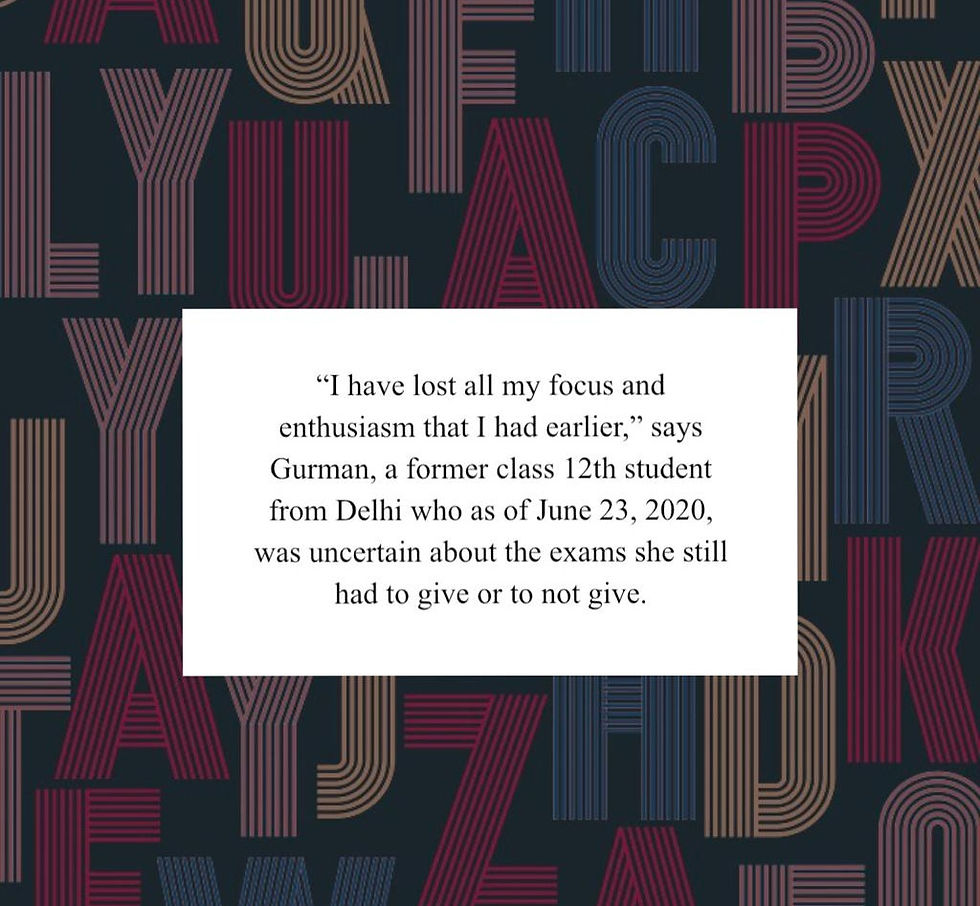MENTAL HEALTH SERIES: A LISTICLE TO HELP A LOVED ONE WITH SUICIDAL TENDENCIES
- period t

- Jul 31, 2020
- 4 min read
BY: LIPIKA IGATPURIKAR AND SANIA HYDER
TW: SUICIDE

ARTWORK BY: ANJANA KASHYAP
Suicide, or taking your own life, is a tragic reaction to stressful life situations — and even more tragic because suicide can be prevented.
There are a lot of reasons why someone would take this step. The most common reason would be being unable to cope with tragedy or a dire situation that one may be overwhelmed with or feel like there is no way out of.
Depression, anxiety, and other mental illnesses like bipolar disorders, when left untreated also cause suicidal intent. Substance abuse, bullying, physical or/and sexual abuse, childhood trauma victims are at risk of suicide.
According to the WHO close to 800, 000 people die by suicide every year. Furthermore, for each death that is caused by suicide, there are more than 20 other individuals that attempt suicide. Suicidal thoughts and attempted suicide take an emotional toll. For instance, one may be so consumed by suicidal thoughts that one may find it difficult to function in their daily life. And while many attempted suicides are impulsive acts during a moment of crisis, they can leave individuals with permanent serious or severe injuries, such as organ failure or brain damage. For those left behind after a suicide, people known as survivors of suicide grief which leads to depression, anger issues are common.
SIGNS AND SYMPTOMS
NIMH has given a list of symptoms to identify in the context of suicidal tendencies. Some of them are:
- Talking about wanting to die or wanting to kill themselves
- Talking about great guilt or shame
- Talking about feeling trapped or feeling that there are no solutions
- Talking about being a burden to others or feeling unbearable pain (emotional pain or physical pain).
- Withdrawing from family and friends
- Acting anxious or agitated
The entire list is available on the NIMH website.
PREVENTION
According to the National Institute of Mental Health, the key to prevention is noticing the early signs. The #BeThere1To help is a five-step program that lists out ways to help individuals who are suffering. The five “action steps” are:
1. Ask – Ask about their feelings
2. Keep Them Safe – Try to minimize access to items or things that can prove lethal
3. Be There – Listen and acknowledge
4. Help Them Stay Connected with the people around them
5. Stay Connected with them
There are also professional methods such as the universal screening test and usage of electronic health records to help understand if someone is considering suicide.
TREATMENT
There are many ways to treat suicidal tendencies and reduce the intensity of the thoughts. The effectiveness of each treatment differs from person to person.
1. BRIEF INTERVENTIONS: These are essentially the involvement of an external organization or person to help the person. This can be done by creating a safety plan that mainly reduces access to lethal objects. Individuals carrying out these interventions carry out follow up calls to discuss the person’s thoughts and feelings; this has shown to reduce the risk of death by suicide.
2. PSYCHOTHERAPY: “Multiple types of psychosocial interventions have been found to help individuals who have attempted suicide” (NIMH). Psychotherapy mainly includes Cognitive Behavioral Therapy and Dialectic Behavior Therapy. Both CBT and DBT are helpful in preventing future risks.
3. MEDICATION: Psychiatrists may provide medication to their patients if they feel that it may reduce the possible danger of death by suicide. The medication also helps stabilize one’s mood and may help maintain chemical balance in the brain, which may in turn help the individual.
4. COLLABORATIVE CARE: Collaborative Care is the addition of a mental health specialist and behavioral health manager on the team that provides primary care. This helps look after both the physical and mental health to treat the underlying reasons that were causing suicidal intent.
(For more information, visit the NIMH site)
Suicide is never easy to consider, and if a person is having suicidal ideation, it is important to understand that they may be in major distress. If you feel that an individual may be at risk, get them help. Directing an individual towards help, or personally getting them help may save a life. There is no alternative to professional help in a lot of cases.
To everyone who says death by suicide is an act of cowardice, it is not. It takes an immense amount of pain to push someone to a point of no return. It is never okay to blame the victim. Instead, attempt to comprehend the reason behind it, and be compassionate while talking about them.
IF YOU, OR SOMEONE CLOSE TO YOU, IS EVER FEELING SUICIDAL, PLEASE CALL THE FOLLOWING NUMBERS:
- AASRA: +91-9820466726 – Main helpline available 24x7.
http://www.aasra.info/helpline.html - This page has a helpline number for each state.
- Fortis Stress Helpline: +918376804102
- Sumaitri: 011-23389090. Mon-Fri 2pm to 10pm and Sat-Sun 10 & to 10pm
- Sanjeevani: 011-24311918, 24318883. Timings: 10 a.m. to 5.30 p.m. (Monday to Friday)
- Roshni: +914066202000 Monday to Saturday between 11 am to 9 pm
- ICALL: 022-25521111/+91-52987821 – Available from 10 AM-8 PM from Monday to Saturday
Mental health issues are as serious as the next physical health diagnosis. It is time that we start taking mental health seriously. Make a safe space for people around you, be kind, be patient, do not judge, and believe people when they reach out to you. Remember, you may never know what people around you may be going through.
This article marks the end of our MENTAL HEALTH series. We hope that we have helped you understand the topic a bit more. We will see you soon in our next edition.
Thank you for reading,
PERIODT.






Comments